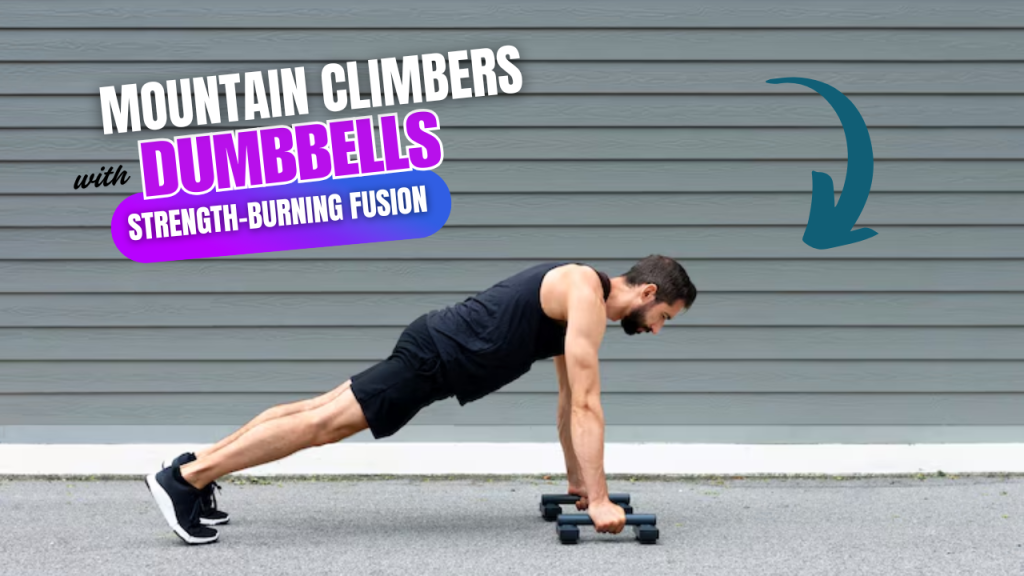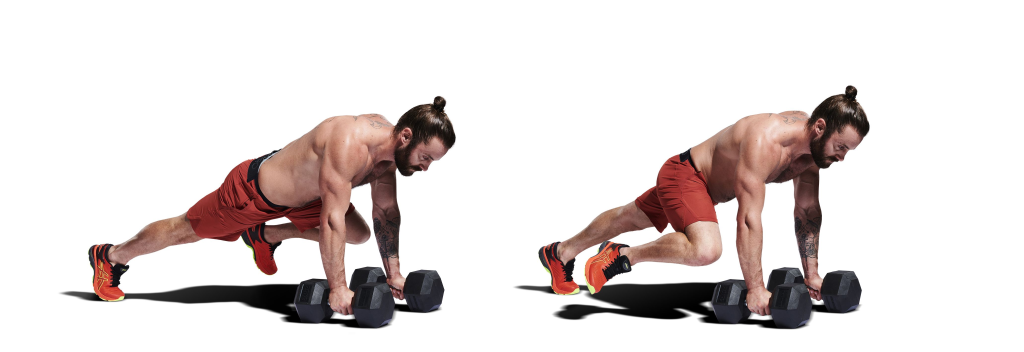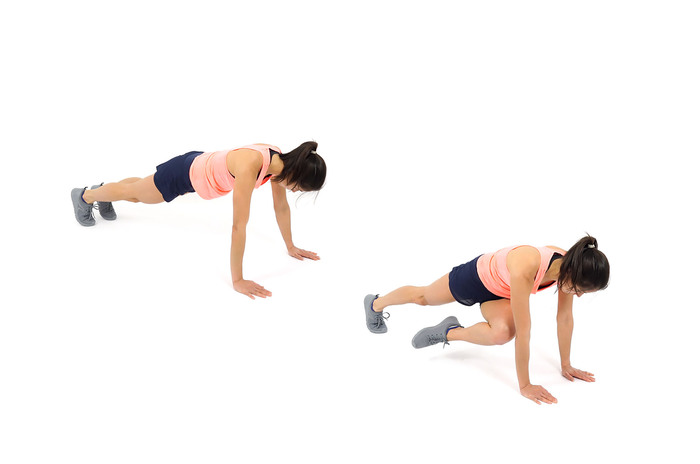Brace Yourself: This Isn’t Your Average Core Workout
Ever thought mountain climbers were tough? Now, picture holding dumbbells while doing them.
Welcome to the next evolution in functional fitness—a fusion of cardio and resistance training that torches fat, ignites core strength and redefines what a “full-body burn” really means.
This hybrid movement isn’t just intense—it’s intelligently effective. And chances are, you’ve never added this dynamic duo to your routine.

What Can Happen After 30 Days of Dumbbell Mountain Climbers?
| Benefit | Description |
|---|---|
| Fat Burn & Leaner Physique | Increased heart rate and calorie burn can lead to visible fat loss and toning. |
| Improved Muscle Definition | Shoulders, arms, core, and glutes become more sculpted and firm. |
| Boosted Endurance | Enhanced cardiovascular and muscular endurance from high-intensity reps. |
| Stronger Core Stability | Improved posture, balance, and reduced risk of back pain. |
| Faster Metabolism | Elevated metabolic rate due to consistent full-body engagement. |
| Better Mind-Muscle Connection | Improved movement control, coordination, and body awareness. |
| Increased Flexibility | Dynamic movement promotes hip mobility and joint flexibility. |
| More Energy & Focus | Enhanced circulation and oxygen flow lead to higher daily energy levels. |
Why Combine Mountain Climbers with Dumbbells?
1. Functional Efficiency at Its Finest
Mountain climbers alone are a powerhouse for heart rate elevation and core stability. But when you add dumbbells, your body recruits more muscles—especially in the shoulders, chest, arms, and even your grip.
You’re not just working harder—you’re working smarter, hitting multiple muscle groups with a single move.
Did you know?
Holding dumbbells while performing planking movements increases shoulder stability and helps reduce wrist strain compared to palm-on-floor support.
2. Myth Buster: “Cardio Doesn’t Build Strength”
Let’s debunk a common fitness myth. Many believe cardio and strength should be trained separately. But hybrid movements like dumbbell mountain climbers prove otherwise.
This combination not only elevates your heart rate like HIIT cardio, but also challenges your muscular endurance and strength simultaneously—especially in the stabilizers and posterior chain.
3. Core Engagement on Overdrive
Mountain climbers are already core-intensive, targeting the rectus abdominis, obliques, and hip flexors.
Now, add the dumbbell factor: your stabilizing muscles kick into overdrive to keep you balanced and aligned.
This results in:
- Better anti-rotation core strength
- Stronger spinal stability
- Increased balance and coordination
4. Shoulder & Arm Definition Boost
When your hands grip dumbbells, your upper body isn’t just passively holding form—it’s actively resisting gravity and motion.
Your delts, biceps, triceps, and traps are all engaged as you drive your knees forward and brace your torso.
Bonus Burn: You get isometric strength training in your upper body while doing a metabolic conditioning move.
How to Perform Dumbbell Mountain Climbers (the Right Way)

- Grab two dumbbells (hex-shaped are ideal to avoid rolling).
- Place them shoulder-width apart, and assume a high plank position, gripping each dumbbell.
- Engage your core, keep your spine neutral, and begin driving your knees toward your chest alternately, as fast or controlled as you can manage.
- Keep your shoulders stacked over the dumbbells and avoid bouncing your hips.
Pro tip: Start with light dumbbells (5–10 lbs) to master form before going heavier.
Variations to Try for Added Challenge
1. Cross-Body Dumbbell Climbers

Bring the knee toward the opposite elbow to fire up the obliques.
2. Slow-Mo Climbers

Move deliberately, focusing on core tension and muscle contraction instead of speed.
3. Push-Up + Climber Combo
Add a push-up between every four climbers to blend push strength and endurance.
The Science of the Burn
What makes this combo so uniquely effective? It blends aerobic and anaerobic systems.
- You’re spiking heart rate (calorie burn)
- You’re activating fast-twitch muscles (muscle strength)
- You’re enhancing neuromuscular coordination (athletic performance)
Translation? You’re burning fat, building strength, and improving overall fitness—at once.
Perfect For:
Home workouts
Gym training
Quick HIIT sessions
Athletes & fitness enthusiasts looking for a functional edge
Did You Know?
A study published in the Journal of Strength and Conditioning Research found that compound core movements like loaded climbers lead to greater improvements in trunk endurance and postural control compared to isolated crunch-based exercises.
Final Thoughts: A Workout Hack Hiding in Plain Sight
Mountain climbers with dumbbells aren’t just a harder version of a cardio move—they’re a training secret that delivers high payoff for minimal time.
You’re not just sculpting your core. You’re forging total-body resilience, torching fat, and building real-world strength.
This is the kind of innovation your workout plan didn’t know it needed—until now.
Frequently Asked Questions (FAQs)
Can beginners try mountain climbers with dumbbells?
Yes, but it’s important to start with lightweight dumbbells (3–8 lbs) and focus on form. If wrist stability is an issue, begin with standard mountain climbers and progress to the dumbbell version once you build strength and control.
What kind of dumbbells should I use?
Hexagonal dumbbells are best because they won’t roll, providing better stability during the movement. Choose rubber-coated options if you’re working out on hard floors to avoid slipping.
Are dumbbell mountain climbers good for weight loss?
Absolutely. This move combines cardio and strength training, which elevates your heart rate and builds lean muscle—two key components for effective fat loss.
Will this exercise build muscle or just burn fat?
Both. While it’s primarily a conditioning move, it activates and strengthens multiple muscle groups including shoulders, arms, core, glutes, and legs. Over time, this contributes to improved muscle tone and definition.
Can I use kettlebells instead of dumbbells?
It’s not recommended unless the kettlebells are flat-based and stable. Most kettlebells have rounded bottoms, which increases the risk of tipping and injury during high-paced movements like mountain climbers.
How often should I include this in my workouts?
2–3 times per week is sufficient, especially if your goal is fat loss or metabolic conditioning. It can be part of a circuit, HIIT routine, or warm-up finisher.
Is this safe for people with back pain?
If you have existing back issues, consult a healthcare provider first. That said, when done with proper form, this movement can strengthen the core and support spinal health—but only if performed without compensating or arching the lower back.





